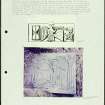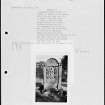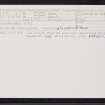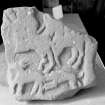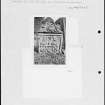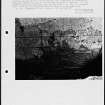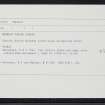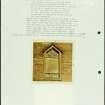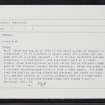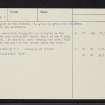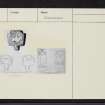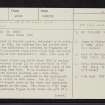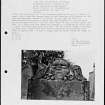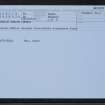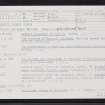Pricing Change
New pricing for orders of material from this site will come into place shortly. Charges for supply of digital images, digitisation on demand, prints and licensing will be altered.
Upcoming Maintenance
Please be advised that this website will undergo scheduled maintenance on the following dates:
Thursday, 9 January: 11:00 AM - 3:00 PM
Thursday, 23 January: 11:00 AM - 3:00 PM
Thursday, 30 January: 11:00 AM - 3:00 PM
During these times, some functionality such as image purchasing may be temporarily unavailable. We apologise for any inconvenience this may cause.
Menmuir Parish Church
Carved Stone (Early Medieval), Carved Stone(S) (Early Medieval), Church (19th Century)
Site Name Menmuir Parish Church
Classification Carved Stone (Early Medieval), Carved Stone(S) (Early Medieval), Church (19th Century)
Canmore ID 35131
Site Number NO56SW 3
NGR NO 53423 64363
Datum OSGB36 - NGR
Permalink http://canmore.org.uk/site/35131
- Council Angus
- Parish Menmuir
- Former Region Tayside
- Former District Angus
- Former County Angus
NO56SW 3.00 53411 64365
NO56SW 3.01 5342 6436 Cross-slab (no. 1)
NO56SW 3.02 5342 6436 Sculptured stone (no. 2)
NO56SW 3.03 5342 6436 Cross-slab (no. 3)
NO56SW 3.04 5342 6436 Sculptured stone and Cross-slab (nos. 4 and 5)
NO56SW 3.05 5342 6436 Cross-slab (no. 6)
NO56SW 3.06 53439 64367 Churchyard
(NO 5342 6436) Ch (NAT)
Cross Slabs (NR)
OS 1:10,000 map, (1972).
The church of Menmuir parish, dedicated to St Aidan, is mentioned in 1275, but evidence for the earlier date suggested by the dedication is provided by fragments of two Class III sculptured cross-slabs found when the walls of the churchyard were demolished c 1844. (See also NO56SW 4) The present church was built about 1842 to replace either the medieval church (Jervise 1853) or another built in 1767 (Warden 1884) but attached to the N side is the burial aisle of the Carnegies dating from 1639. It is enclosed by a high stone wall with massive moulding and a date stone.
The two cross-slabs, preserved in the churchyard, are carved in relief on both faces. One is 3'5" high bearing a full-length cross on the front and equestrian and other figures on the back. The other is 1'2 1/2" high bearing an equestrian figure on the front and part of a standing figure on the reverse. They are of grey and red sandstone.
A J Warden 1884; A Jervise 1853; J R Allen and J Anderson 1903.
Severe stugged ashlar rectangle with 2-light 4-centre arched windows: small square bellcote. Interior has 4-centre rib-arched ceiling and gallery, 1842. David Smith (Dundee) archt. Refurnished. Pulpit etc., 1947. Carnegy vault incorporated underneath church at centre of N. side, 1639 panel on wall above. Fine 1717 Fairweather tablet on S. wall. (Historic Environment Scotland List Entry)
Field Visit (11 July 1958)
The two cross-slab fragments are situated in the corner of the open railed-off burial vault on the N side of the church. An armorial panel bearing the date '1639' is built into the wall of the church above the vault.
Visited by OS (JLD) 11 July 1958.
Field Visit (1 November 1967)
As described by OS field surveyor (JLD).
Surveyed at 1:2500.
Visited by OS (RL) 1 November 1967.
Note (1983)
Kirkton of Menmuir NO 534 643 NO 56 SW 3
About 1843, when the churchyard wall was demolished, two sculptured stones were discovered; one is a Class 111 Pictish cross-slab, the other a rectangular fragment with a projecting tenon. In 1943, part of a second cross-slab, and two other sculptured fragments, were dug up in the manse garden.
RCAHMS 1983
(NSA, xi, Forfar, 657-8; Stuart 1856, 29-30, plate xcii, ho. 3; 41, plate cxxxii, no. 1; Allen and Anderson 1903, iii, 263-5; Stevenson 1959, 43; Coutts 1970, 63, no. 23).
Note (1984)
Menmuir, Parish Church and Burial-ground NO 534 643 NO56SW 3
There are no visible remains of the medieval parish church of Menmuir. The present church was built in 1842 replacing a church built in 1767. When the wall of the burial ground was taken down, about 1843, two sculptured stones were discovered; one is a Class III Pictish cross-slab, the other a rectangular fragment with a projecting tenon. In 1943 part of a second cross-slab and two other sculptured fragments were dug up in the manse garden.
RCAHMS 1984.
(Stat. Acct, v, 1793, 150; Jervise 1882, 303-4; Warden 1880-85, iv, 351-2; Allen and Anderson 1903, iii, 263-5; Hay 1957, 246; Stevenson 1959, 43; Cowan 1967, 146; RCAHMS 1983, p. 21, no. 150).
Reference (1995)
NO 534 643 The five Early Christian cross slabs found at this site were all removed following the closure of the church. They have been put on display in the Meffan Institute, Forfar.
The fragment discovered in 1987 was re-examined and does not bear worn interlace. The pitted surface most closely resembles the 'fire-making stone' from Carlungie Souterrain.
N Atkinson 1995.

























